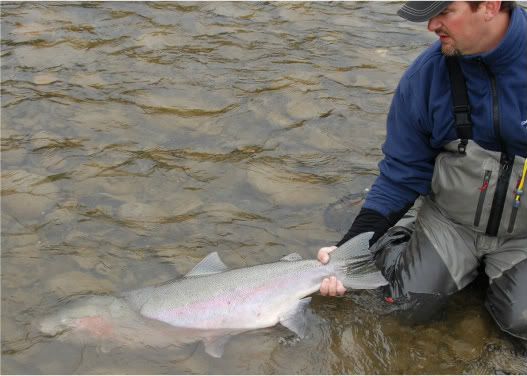I just ran accross this article in the seattle time not sure how I feel about it yet. Doesnt sound that good at first look.
Bush plans to boost logging in NW
By Craig Welch
Seattle Times staff reporter
E-mail this article
Print this article
Search web archive
The Bush administration wants to rewrite logging rules for Northwest forests to allow for short-term damage to salmon-bearing streams, claiming forest managers still could protect the overall health of watersheds.
The stream and fish rules, created by the Clinton administration, were the foundation for a series of high-profile environmental lawsuits that have tied up hundreds of Forest Service and Bureau of Land Management (BLM) timber sales since 1999.
The agencies' proposed rule change will go through a nine-month review process, but both supporters and opponents expect the proposal to wind up in court.
Administration officials yesterday suggested the proposed new language was a clarification of existing forest policy that had been misinterpreted by the courts.
But environmentalists dismissed that characterization as "revisionist history at its worst."
"They're saying, 'We may be degrading a few acres, but don't worry, overall, things are going to get better. Trust us,' " said Andy Stahl, director of the whistle-blower group Forest Service Employees for Environmental Ethics. "And they're saying, this is what (the Clinton administration) meant all along."
But industry groups said it was about time.
"The agencies do protect water and fisheries," said Chris West, spokesman for the American Forest Resource Council, a timber-industry group. "The successes environmental groups have had have been on pure technicalities."
Yesterday's announcement is in response to a court ruling last year that shelved 120 or more timber sales on thousands of acres in Washington, Oregon and Northern California.
But it's also part of a broad administration push to boost Northwest timber harvests back to levels agencies originally projected under the landmark 1994 Northwest Forest Plan.
That plan attempted to balance the demand for timber with the need to protect dwindling spotted-owl habitat. It made logging off limits on roughly 80 percent of 24.5 million acres of federal land in the three states. Agencies had projected loggers could take 811 million board feet of timber a year off remaining lands, but in recent years they haven't come close.
The industry took out only 145 million board feet of timber in 2000, and 300 million in 2001.
President Bush, who generated more than $1 million in contributions from the timber industry during one campaign stop in 2000, had promised to try to increase logging access to the woods.
"The BLM has had a hard time meeting its projections and the main reason is the variety of lawsuits," said BLM spokesman Chris Strebig.
The bulk of those lawsuits have focused on two facets of the plan, both of which the administration is now moving to change.
One, called "survey and manage," refers to guidelines that require forest officials to survey for hundreds of plants, fungi and wildlife that depend on old-growth forests before approving a timber sale. Earlier this fall, the administration announced it wants to recast those rules.
The other area was the so-called "aquatic conservation strategy," which the administration moved to rework yesterday.
In June 2001, the 9th U.S. Circuit Court of Appeals ruled that forest managers weren't considering the short-term or cumulative impacts timber harvests have on threatened coho-salmon runs.
Instead, the federal managers had been looking 10 to 20 years into the future and deciding how or whether each sale by itself affected the overall watershed.
Not counting the BLM timber sales, the Forest Service's sales alone that were stalled by the ruling would have produced 250 million board feet of timber.
"They'd been rubber-stamping these individual timber plans and saying that, with restoration projects, over time, is part of a bigger strategy to protect the watershed," said Glen Spain, with the Pacific Coast Federation of Fishermen's Associations, which filed the original suit. "But if you do enough of these little projects, you won't have much of a watershed."
While logging projects can take place on a few dozen or a few hundred acres, watersheds are often 20 to 200 square miles in size. The Forest Service and BLM contend they still do look at site-specific effects of logging on salmon streams, but that it isn't practical to evaluate each project with the same depth they use to review watershed-level impacts, said Phil Mattson, assistant director of strategic planning for the Forest Service in Portland.
Instead, they say, existing standards and guidelines for individual projects, if followed, are adequate to protect the watershed.
In other words, "even though there may be some short-term effects, the overall aquatic quality will continue to improve," said Forest Service spokesman Rex Holloway.
For timber interests, the proposed change is long overdue.
"We asked the previous administration to pursue this, to no avail," said West. "It's ironic that the Bush administration is doing what has to be done to make the Clinton-Gore forest plan work."
Environmentalists, meanwhile, also found irony. Said Stahl: "Having been beat up by the District Court, then the 9th Circuit, now Bush is saying, 'Wait, we'll just change it to what Clinton really meant.' "
Craig Welch: 206-464-2093 or cwelch@seattletimes.com.















 Previous Topic
Previous Topic Index
Index

